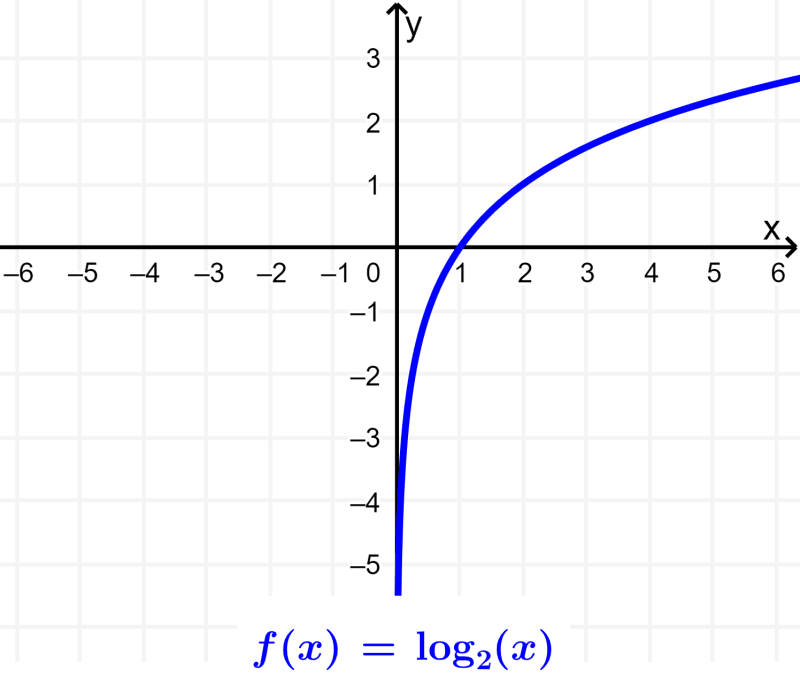Logarithmic functions are the inverse functions of exponential functions since they reverse the effect of these functions. To solve logarithmic functions, it is necessary to know the properties of logarithms since they allow us to rewrite logarithmic expressions in more manageable forms.
Here, we will look at a summary of the logarithmic functions along with their most important properties. In addition, we will look at several examples with answers to learn to solve logarithmic functions using their properties and their inverse function.
Summary of logarithmic functions
The logarithmic functions are the inverse functions of the exponential functions. Recall that an exponential function has the general form $latex f(x)={{b}^x}$, where, $latex b>0$.
On the other hand, since logarithmic functions are defined as the inverse of exponentiation, the logarithmic function is written as $latex \log_{b}(x)=y$, where b is the base, y is the exponent and x is the argument.
Solving logarithmic functions
To solve logarithmic functions, we can make use of the exponential functions in the given function. For example, the natural logarithm denoted ln is the inverse of e. This means that we can reverse the effect of one function with the other:
$latex \ln ({{e}^x})=x$
$latex {{e}^{\ln (x)}}=x$
We also have to know the properties of logarithms to solve logarithmic functions:
Product rule: The logarithm of a product rule states that the logarithm of the product of two numbers with a common base is equal to the sum of the individual logarithms:
$latex \log_{b}(p/q)=\log_{b}(p)-\log_{b}(q)$
Quotient rule: The logarithm of a quotient rule indicates that the logarithm of the ratio of two numbers with the same base is equal to the difference of the logarithms:
$latex \log_{b}({{p}^q})=q\log_{b}(p)$
Power rule: The logarithm of a power rule indicates that the logarithm of a number with a rational exponent is equal to the product of the exponent and its logarithm:
$latex \log_{b}({{p}^q})=q\log_{b}(p)$
Zero exponent rule:
$latex \log_{b}(1)=0$
Change of bases rule:
$latex \log_{a}(p)=\frac{\log_{x}(p)}{\log_{x}(a)}$
Examples with answers of logarithmic function problems
With the following examples, you can practice what you have learned about logarithmic functions. Each example has the respective solution to learn about the reasoning used. It is advisable to try to solve the problem first before looking at the solution.
EXAMPLE 1
Rewrite the exponential function $latex {{8}^2}=64$ to its equivalent logarithmic function.
Solution
In the exponential function $latex {{8}^2}=64$, the base is 8, the exponent is 2, and the argument is 64. Therefore, $latex {{8}^2}=64$ in a logarithmic function is:
$latex \log_{8}(64)=2$
EXAMPLE 2
Write the log equivalent of $latex {{6}^3}=216$.
Solution
In this case, the base equals 6, the exponent is 3, and the argument is 216. Therefore, the equivalent logarithmic function is:
$latex \log_{6}(216)=3$
EXAMPLE 3
Solve the logarithmic expression for x: $latex \log_{5}(x)=2$.
Solution
Many of the logarithmic equations are more easily solved by rewriting them as exponential equations. Therefore, we can rewrite the logarithmic function as follows:
$latex \log_{5}(x)=2$
⇒ $latex {{5}^2}=x$
⇒ $latex x=25$
EXAMPLE 4
If $latex 2 \log(x)=4 \log(3)$, find the value of x.
Solution
We can start by dividing the entire expression by 2 to simplify:
$latex \frac{2\log (x)}{2}=\frac{4 \log (3)}{2}$
$latex \log (x)=2\log (3)$
Now, we can use the logarithm of a power rule to rewrite the expression on the right:
$latex \log (x)=\log ({{3}^2})$
$latex \log (x)=\log (9)$
$latex x=9$
EXAMPLE 5
Solve for x in the following logarithmic function: $latex \log_{2}(x-1)=5$.
Solution
To facilitate the resolution, we rewrite the logarithm in exponential form:
$latex \log_{2}(x-1)=5$
⇒ $latex x-1={{2}^5}$
Now, we have an algebraic equation and we can easily solve for x:
$latex x-1=32$
$latex x=32+1$
$latex x=33$
EXAMPLE 6
Solve for the logarithmic function $latex \log(x)=\log(2)+\log(5)$.
Solution
Here, we have to use the product rule to combine the logarithms on the right side of the expression:
$latex \log(x)=\log(2)+\log(5)$
$latex \log(x)=\log(2\times 5)$
$latex \log(x)=\log(10)$
$latex x=10$
EXAMPLE 7
Solve for the logarithmic function $latex \log_{x}(4x-3)=2$.
Solution
We have to write the logarithm in exponential form to facilitate the resolution of the problem:
$latex \log_{x}(4x-3)=2$
⇒ $latex {{x}^2}=4x-3$
Now, we have a quadratic equation, which we can solve using factoring:
$latex {{x}^2}=4x-3$
$latex {{x}^2}-4x+3=0$
$latex (x-1)(x-3)=0$
$latex x=1$ o $latex x=3$
The base of a logarithm can never be equal to 1, so the solution to the logarithmic function is $latex x=3$.
Logarithmic function problems – Practice
Practice and test your knowledge of logarithmic functions with these problems. Simply choose an answer and verify it by clicking “Check”. You can look at the solved examples above carefully if you have trouble solving these exercises.
See also
Interested in learning more about logarithmic functions? Take a look at these pages:




